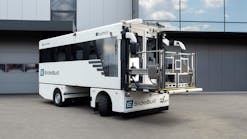Global IT provider SITA and Hamad International Airport (HIA) today signed a Memorandum of Understanding (MoU) which provides a framework for the two partners to trial and enhance innovative passenger processing solutions at HIA. The MoU was signed jointly by Hamad International Airport Chief Operating Officer, Engr. Badr Mohammed Al Meer and Hani El-Assaad, SITA President, Middle East, India and Africa, at an event which took place at Qatar’s five-star airport.
The predominant focus of the MoU is to advance HIA’s initiative to implement seamless identity management across all key passenger service points using biometrics. Trials will also be held to evaluate the effectiveness of robots for passenger facilitation; blockchain technology for rapid and secure sharing of data across stakeholders; and the potential use of augmented and virtual reality for operational concepts.
It was also announced at the event that SITA will be supplying and commissioning 62 of its next-generation common-use check-in kiosks, with bag tag printing capability. This will enhance passenger experience for self-service check-in and enable progressive deployment of self-service bag-drop facilities. SITA will also be supplying and commissioning boarding pass verification e-gates which will be located prior to departures’ border control. These kiosks and e-gates will have the ability to use biometrics to identify passengers.
In line with HIA’s strategy, all systems that are being acquired and upgraded for passenger processing, such as for check-in, bag drop, and aircraft boarding, are specified for integration with biometric sensors. Such capability will not only provide enhanced security oversight but also holds tremendous potential to deliver a smooth end-to-end journey through the airport using a single biometric token.
The formalization of this partnership follows the successful industry-first pilot of biometric exit checks conducted by SITA and HIA in Qatar’s airport during 2016. These early trials using SITA’s Smart PathTMtechnology at HIA, in collaboration with the national carrier Qatar Airways, Government Security Agencies and the national regulator, Qatar Civil Aviation Authority, have led to SITA optimizing the technology and subsequently implementing it with major airports and airlines around the world.
A key benefit of SITA's Smart PathTM technology is that it seamlessly integrates into existing common-use airport infrastructure and airline systems, allowing passengers to use biometrics each step of the way – doing away with the need to present travel documents beyond the first step in the journey.
Badr Mohammed Al Meer, Chief Operating Officer at Hamad International Airport, said: “HIA’s efforts towards innovation and its strategic alliances with key partners such as SITA, all contribute towards its ‘Smart Airport’ vision that was officially launched in May 2016 under the patronage of HE the Prime Minister and Minister of Interior Sheikh Abdullah bin Nasser bin Khalifa al-Thani. Our aim is to empower our passengers to experience a seamless journey at their own pace, all the while keeping them informed about what matters to them most.
“The use of biometrics as the only verification required at each passenger touch point along the airport journey will go a long way in improving the flow of passengers, providing a better travel experience as well as greater operational visibility for the stakeholders. SITA has already demonstrated excellent capability and agility in pioneering and optimizing biometric exit checks for the boarding process at HIA. We believe that such joint efforts will contribute to digital transformations across the air transport industry.”
Hani El-Assaad, SITA President, Middle East, India and Africa said: “We at SITA welcome the opportunity to work with a world-leading hub such as Hamad International Airport to push the boundaries of innovation to truly change the way passengers will travel in future. Our vision to make air travel easier at every step fits neatly with HIA’s ‘Smart Airport’ vision and together we can help reshape the future of air transport.”




